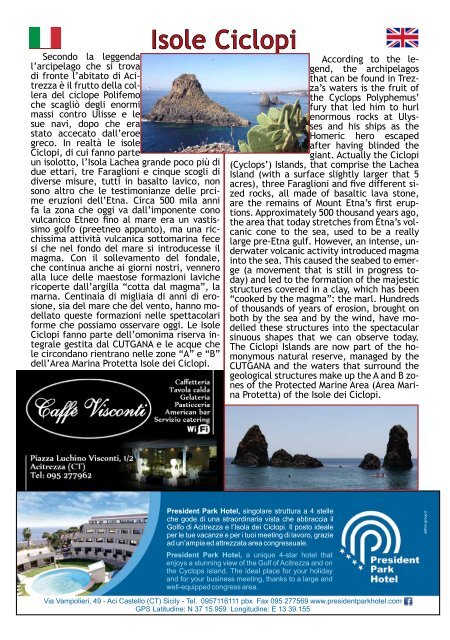Guida turistica Aci Trezza 2013 - Xiphonia Coop. a rl - Turismo ad ...
Guida turistica Aci Trezza 2013 - Xiphonia Coop. a rl - Turismo ad ...
Guida turistica Aci Trezza 2013 - Xiphonia Coop. a rl - Turismo ad ...
Create successful ePaper yourself
Turn your PDF publications into a flip-book with our unique Google optimized e-Paper software.
Secondo la leggenda<br />
l’arcipelago che si trova<br />
di fronte l’abitato di <strong>Aci</strong>trezza<br />
è il frutto della collera<br />
del ciclope Polifemo<br />
che scagliò degli enormi<br />
massi contro Ulisse e le<br />
sue navi, dopo che era<br />
stato accecato dall’eroe<br />
greco. In realtà le isole<br />
Ciclopi, di cui fanno parte<br />
un isolotto, l’Isola Lachea grande poco più di<br />
due ettari, tre Faraglioni e cinque scogli di<br />
diverse misure, tutti in basalto lavico, non<br />
sono altro che le testimonianze delle prcime<br />
eruzioni dell’Etna. Circa 500 mila anni<br />
fa la zona che oggi va dall’imponente cono<br />
vulcanico Etneo fino al mare era un vastissimo<br />
golfo (preetneo appunto), ma una ricchissima<br />
attività vulcanica sottomarina fece<br />
si che nel fondo del mare si introducesse il<br />
magma. Con il sollevamento del fondale,<br />
che continua anche ai giorni nostri, vennero<br />
alla luce delle maestose formazioni laviche<br />
ricoperte dall’argilla “cotta dal magma”, la<br />
marna. Centinaia di migliaia di anni di erosione,<br />
sia del mare che del vento, hanno modellato<br />
queste formazioni nelle spettacolari<br />
forme che possiamo osservare oggi. Le Isole<br />
Ciclopi fanno parte dell’omonima riserva integrale<br />
gestita dal CUTGANA e le acque che<br />
le circondano rientrano nelle zone “A” e “B”<br />
dell’Area Marina Protetta Isole dei Ciclopi.<br />
Isole Ciclopi<br />
According to the legend,<br />
the archipelagos<br />
that can be found in <strong>Trezza</strong>’s<br />
waters is the fruit of<br />
the Cyclops Polyphemus’<br />
fury that led him to hu<strong>rl</strong><br />
enormous rocks at Ulysses<br />
and his ships as the<br />
Homeric hero escaped<br />
after having blinded the<br />
giant. Actually the Ciclopi<br />
(Cyclops’) Islands, that comprise the Lachea<br />
Island (with a surface slightly larger that 5<br />
acres), three Faraglioni and five different sized<br />
rocks, all m<strong>ad</strong>e of basaltic lava stone,<br />
are the remains of Mount Etna’s first eruptions.<br />
Approximately 500 thousand years ago,<br />
the area that today stretches from Etna’s volcanic<br />
cone to the sea, used to be a really<br />
large pre-Etna gulf. However, an intense, underwater<br />
volcanic activity introduced magma<br />
into the sea. This caused the seabed to emerge<br />
(a movement that is still in progress today)<br />
and led to the formation of the majestic<br />
structures covered in a clay, which has been<br />
“cooked by the magma”: the ma<strong>rl</strong>. Hundreds<br />
of thousands of years of erosion, brought on<br />
both by the sea and by the wind, have modelled<br />
these structures into the spectacular<br />
sinuous shapes that we can observe today.<br />
The Ciclopi Islands are now part of the homonymous<br />
natural reserve, managed by the<br />
CUTGANA and the waters that surround the<br />
geological structures make up the A and B zones<br />
of the Protected Marine Area (Area Marina<br />
Protetta) of the Isole dei Ciclopi.


